Match Game, The (1973-1982)



Not long after The Match Game went off NBC, Goodson-Todman Productions was developing a new version for CBS. Hollywood Squares, with its nine celebrities giving funny answers to questions, was then the big hit in daytime TV and the show to copy. The new format Match Game used six but as with Squares, two contestants would compete to evaluate the stars’ responses. The questions also became more likely to lead to funny, slightly naughty answers. Instead of asking people to name their favorite cheese, as he had on the old version, Rayburn would read the straight line to a joke and the celebs would have to supply the punch line.
Match Game ’73 went on the air July 2, 1973. The first panel consisted of Michael Landon, Vicki Lawrence, Jack Klugman, Jo Ann Pflug, Richard Dawson and Anita Gillette. Dawson was a regular from the start…until mid-’78 when he became too busy with Family Feud — a show that seems to have been inspired by the “audience match” bonus round on Match Game. Charles Nelson Reilly and Brett Somers Klugman (ex-spouse of Jack) first appeared on the panel in the show’s third week and soon after came back as regulars.
For a long time, the daytime version changed names every year — to Match Game ’74, then Match Game ’75 and so on. A once-a-week syndicated version for evenings was called Match Game PM and ran from 1975 to 1981. In 1979, CBS cancelled the daytime version and Goodson-Todman immediately offered a syndicated five-a-week version called simply Match Game, with no identifying date since shows were run and rerun at different times. (The tickets above that lack the CBS eye were from tapings for syndicated shows. CBS policy was to only put their logo on tickets for shows that aired on CBS.)
Episodes were taped in long blocks to accomodate Gene Rayburn, who commuted from a home on the East Coast. Sometimes, they’d tape six days a week, five shows a day, for two or three weeks at a stretch. That sometimes made it difficult to secure enough of an audience to fill all the seats. As you can see, the tickets promised prizes to those who came to watch. And on almost every tape day, people dispensing free tickets could be found over at Farmer’s Market, the tourist attraction located next to CBS Television City. Sometimes, they’d “sell” the evening tapings by pointing out that the celebrity panelists often got a bit tipsy over the dinner break from wine and other spirits. This is why the Thursday and Friday shows, which taped after supper, were usually funnier and full of bleeps.
Even after the syndicated version ended, Match Game did not stay off the air for long. By October of ’83, it was back on network as one half of The Match Game-Hollywood Squares Hour, thereby partnering with the show it tried to emulate in the first place. Another version ran from 1990 to 1991 and yet another from 1998 to 1999.
[Thanks to Curt Alliaume for correcting an error that was in this page as originally posted.]
Match Game, The (1962-1969)

Here’s the first version of The Match Game, which was a simpler show, less prone to dirty answers and drunken celebrities than the revival that followed. In this one, there were two competing teams, each with a celebrity and two civilians. Host Gene Rayburn would ask a question which could have multiple answers like, “Name a great magician” or “Besides pepperoni, what’s a great topping for pizza?” All six people would write down, then unveil their answers. On each team, if two of them matched, they earned $25. If all three matched, they got $50. The first team to reach $100 won the game and a hundred dollars and the right to play the Audience Match for additional cash. The show went on the air the last day of 1962 and lasted until September of ’69. Less than four years later, the revised version went on the air as Match Game ’73.
Jeopardy! (1964-1975)
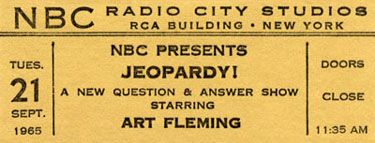
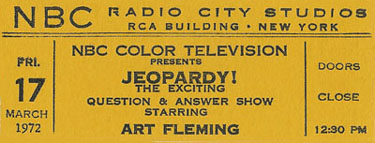
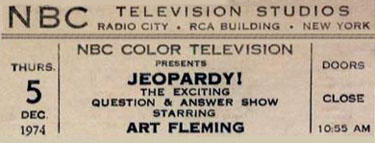
A popular staple of late night comedy shows was always the bit where they give the answer and then the question. Steve Allen did it as The Question Man, and Johnny Carson did the exact same thing as Karnak the Magnificent. (“The answer is…Sis Boom Bah. The question is: Describe the sound of a sheep exploding.”) Under the contract of The Merv Griffin Show, his failed NBC afternoon talk show, Merv was owed a couple of commitments for game shows. He originally tried to assemble a comedy quiz program based on the answer-before-the-question premise but it didn’t come together. At the suggestion of his then-wife, he made it a non-comedy show and defied the notion that daytime TV viewers wanted fluff, not hard questions. In no time at all, Jeopardy! became one of the greatest success stories in the history of television. It debuted in March of 1964 and lasted on NBC until January of 1975, so the third ticket above would have been to one of the last tapings. Eleven years is a hefty run but Griffin was still angry at the time, feeling his “baby” could have run much longer.
A lady named Lin Bolen had taken over in the programming division of the network and she had definite ideas about how to reinvent the stodgy old game show. One was to jettison the “old men” who hosted many of them and bring in “young studs” as hosts. Her theory — and it made sense — was that housewives would rather look at Geoff Edwards and Alex Trebek (who were among her finds) than at Art Fleming and Dennis James. She had other theories as well, and she put them to the test when she developed a new game show called Jackpot! She put her new show in the coveted Jeopardy! time slot, moving that show to a later, less desirable hour. Both shows failed. NBC cancelled Jeopardy!…but under the terms of their contract with Griffin’s company, Merv was owed another year of some show, so he came up with Wheel of Fortune. It debuted the Monday following the last Jeopardy! with one of Bolen’s “young stud” discoveries, Chuck Woolery, as the host. In 1978, after Bolen was no longer at NBC, the network tried bringing Jeopardy! back in a slightly-glitzier format — at Griffin’s insistence, with Art Fleming — but it only lasted five months. Then in 1983, with Wheel of Fortune still doing well on NBC daytime, Griffin launched a syndicated nighttime version. It was a smash so Merv immediately revived Jeopardy!, hired Alex Trebek (one of Lin Bolen’s “young studs,” now considerably older) and sold the two shows as a package. He made a gazillion dollars.
Word for Word
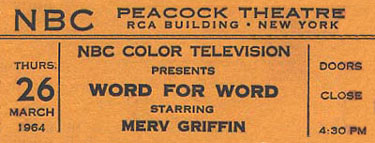
After The Merv Griffin Show left the NBC daytime schedule, Merv returned with a new game show from his own production company. Word for Word involved showing contestants a word and then seeing how many other words they could make using its letters. It lasted a little more than a year before going off but Merv probably didn’t care much. In the meantime, he’d sold NBC a game show called Jeopardy! and soon after, he made a deal to do his own talk show for syndication, so he did just fine. (Ticket courtesy of Brian Gari.)
Tonight Show, The (1962)
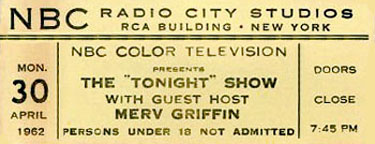
Jack Paar hosted his final episode of Tonight on March 30, 1962. Johnny Carson had been signed to replace him but Johnny was still under contract to host Who Do You Trust on ABC and wouldn’t be free until later that year. So for six months, guest hosts helmed the late night show, starting with Art Linkletter. Among others who took a week or two were Soupy Sales, Jerry Lewis, Joey Bishop, Steve Lawrence, Groucho Marx, Arlene Francis, Mort Sahl, Jack E. Leonard, Hal March, Donald O’Connor and even Paar’s old sidekick, Hugh Downs, who stayed on as announcer for the transition period and hosted at least one week. The above ticket is from one of several weeks hosted by Merv Griffin. NBC had him signed to do The Merv Griffin Show in the afternoons, just to keep him around in case Johnny bombed.
The six months of temps are truly lost episodes. There are no known videotapes or kinescopes, and pretty much everyone has forgotten about the period. My fuzzy memory — I was ten at the time — was that some of the hosts did a pretty good job, perhaps auditioning just in case Johnny didn’t work out. Others figured they had nothing to lose and turned the show into one long commercial for their other endeavors. Reportedly, Carson watched a few broadcasts in the latter category and called NBC to complain that they were destroying the show he was going to be taking over. Dick Cavett, who had previously been a Talent Coordinator for Paar, was on the writing staff.
One other note: Although it was casually referred to as The Tonight Show, it was not called that until Paar left. The Steve Allen version was called Tonight, as was the Paar version for his first few years, after which it became Jack Paar Tonight and then The Jack Paar Show. But Tonight and The Tonight Show were used informally throughout those years. Some TV listings still called it Tonight long after it was The Jack Paar Show on the air. So if one wanted to split follicles, one could say that the first host of The Tonight Show was Art Linkletter.
Merv Griffin Show, The (1962-1963)
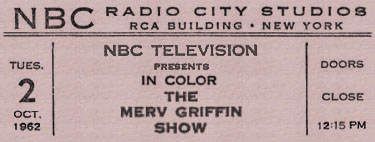
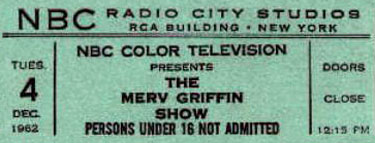
In 1962 when Jack Paar decided to leave Tonight, several names were mentioned as possible replacements. Among them was a former band singer named Merv Griffin, who had recently been hosting the game shows Play Your Hunch for NBC and Keep Talking for CBS. He had also guest-hosted successfully for Paar and probably would have gotten the late night show, had NBC not opted to go with Johnny Carson. But just in case Johnny didn’t work out, NBC also signed Griffin and kept him in the bullpen. Merv hosted Tonight during the interim period after Paar departed but before Carson arrived. And then Merv started an afternoon talk show that debuted October 1, 1962 — the same day Johnny took over The Tonight Show.
As things turned out, Carson’s talk show succeeded but Merv’s did not. It was cancelled in less than a year. But Merv didn’t hurt for the experience. His deal with NBC had guaranteed that his production company could do a couple of game shows for the network. In short order, he was back on the air with Word for Word.
Play Your Hunch
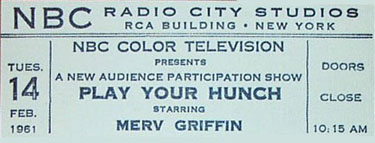
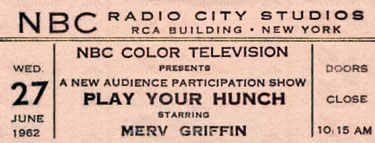
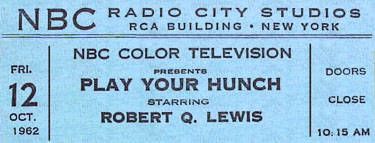
Play Your Hunch was The Game Show That Would Not Die. It started on CBS in the daytime. They cancelled it after six months. It moved to ABC, again in daytime. They cancelled it after six months. Then it moved to NBC, where it lasted four years in daytime with occasional brief forays into nighttime. I don’t know why the above tickets from 1961 and 1962 describe a program that had been on the air since 1958 as “a new audience participation show.”
Merv Griffin hosted for most of the run, and the show was pretty simple. Two teams of contestants (usually husband-wife) would be shown little puzzles, usually involving three people coming out on stage or three objects being unveiled. The correct answer to the question would be one of the three choices, which were labelled X, Y and Z. If you guessed right, you got points. That was it.
One of Merv’s big breaks came about because Play Your Hunch was done live each morning from Studio 6B in what was then called Radio City Studios. Later in the day, long after Merv and his show were out of there, the studio was reset for Jack Paar’s late night show. Mr. Paar was a nervous, superstitious gent and when he was working at NBC, he usually declined to ride the elevators at Rockefeller Center. Instead, he would reach his office each morning by an intricate series of stairwells and short-cuts. His route took him through the usually-deserted Studio 6B but one day, he arrived at the studio much earlier than usual and found himself walking onto a broadcast of Play Your Hunch.
The studio audience went berserk and Paar, finding himself unexpectedly on live TV, attempted to flee. But Merv ran over and got a vise-grip on the bewildered star’s arm to keep him there so he could conduct a brief, funny interview. Paar swore he had no idea that his studio was being used by another program each morning. “So this is what you do in the daytime,” Paar quipped to Griffin, who had occasionally sung on Tonight.
Later, Paar admitted he was impressed with how Griffin had “milked” the accident for its maximum entertainment value by keeping him there. He gave Merv a shot guest-hosting Tonight and when that went well, it led to Griffin becoming a candidate to succeed Paar and also getting signed to do The Merv Griffin Show on NBC’s daytime schedule. Merv left the game show and Gene Rayburn took over for a month. Then NBC decided to put Match Game on later in the year, Rayburn went off to get ready to host that, and Robert Q. Lewis helmed Play Your Hunch until it went off in September of 1963.
WKRP in Cincinnati
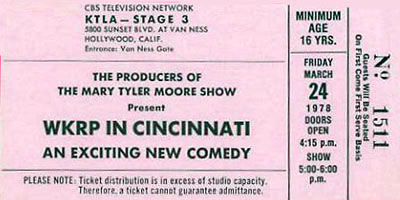
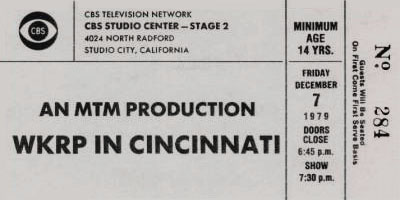
Most folks forget that WKRP in Cincinnati was one of the MTM shows and according to some who worked on the show, the MTM people wanted to forget it, as well. The series had a reasonable run (4 years, 90 episodes) and was nominated in three of its four seasons for the Emmy for “Outstanding Comedy Series.” But those who worked on the show said that the MTM execs — which I guess means Grant Tinker, mainly — didn’t like the show, didn’t mention it in interviews and did nothing when the network screwed with the scripts or moved the show repeatedly from time slot to time slot.
The show was taped — not filmed like most other MTM shows — initially at KTLA, far from the CBS Radford lot where other MTM shows were produced. When they moved to Radford, the producers thought that closeness might cause the MTM execs to welcome them into the family…but Tinker reportedly didn’t even walk across the lot to visit the set. Not only that but Mary Tyler Moore herself was even quoted in one newspaper piece as saying, “I wouldn’t watch it.” No, I don’t understand this attitude, either. It was a funny show with a good cast. I think they were just mad because they couldn’t understand the lyrics in the closing theme song…which were not, by the way, real words. Just gibberish.
To Tell the Truth (1969-1981)
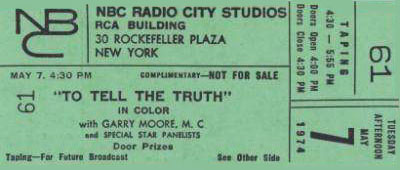
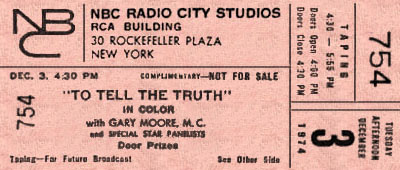
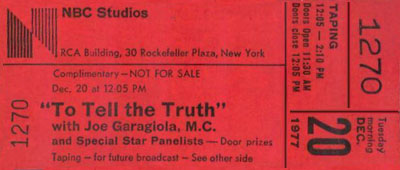
Garry Moore had a long, glorious career hosting game shows. You’d think someone would know how to spell his name on a ticket. This one was for the syndicated daytime version of To Tell the Truth, which ran from 1969 to 1981. Moore hosted until 1977 and then mysteriously disappeared. All of a sudden, Bill Cullen, and then Joe Garagiola were filling in for him “while Garry is off on a much-deserved vacation.” Audiences sensed something was wrong and began bombarding the show with mail asking what was really happening, and was the rumor true that Garry had died? No, it wasn’t — but the correspondents were right that something was wrong.
Moore had developed a cancerous node in his throat, and was off for a few months while it was removed and he got his voice back. He decided not to return to the daily or weekly grind and to retire but to deal with the rumors, he came back and hosted To Tell the Truth for one last time. His surprise walk-on at the beginning stunned the studio audience and they gave him one of the most enthusiastic, loving ovations ever on television, then later in the show fell properly silent as he explained about his operation and his retirement. Thereafter, Garagiola became the permanent host.
In deference to all the tobacco sponsors he’d had over the years — you can see him smoking incessantly on I’ve Got A Secret, brought to you by Winston cigarettes — Moore did not reveal that he’d had cancer. He died in 1993 and the cause of death was listed as emphysema.
Newhart
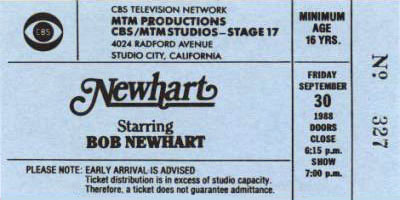
I once asked Kim LeMasters, who ran programming for several years at CBS, if anyone ever came in, pitched him an idea and he bought it on the spot. He said it had happened twice. One was Magnum, P.I. and the other was Newhart. In both cases, the “pitcher” (in the case of Newhart, it was Barry Kemp) came in with a star the network wanted to work with and a format that was fully developed and perfect for that star. And the idea of this show, with Bob running an inn and putting up with odd neighbors and occupants, was pretty darn ideal for Mr. Newhart.
As you can see from the above ticket, it was done on Stage 17 at the CBS Radford lot, which was the same place where Bob did The Bob Newhart Show for 142 episodes. This one lasted 184, which must be some kind of industry record for one-two punches. (To balance, Newhart’s next sitcom — the one I worked on, of course — lasted 33 episodes, and the one after that lasted 22.) The early episodes of Newhart were done on videotape, as opposed to film. Bob, it turned out, decided he didn’t like the look of tape so they converted to film. If you think that sounds silly…hey, you go argue with 184 episodes.
A lot of people think the last one, in which it turned out the entire series was a dream of the character Bob played in his previous series, was one of the most daring, brilliant ideas ever on television. It’s certainly a contender.






